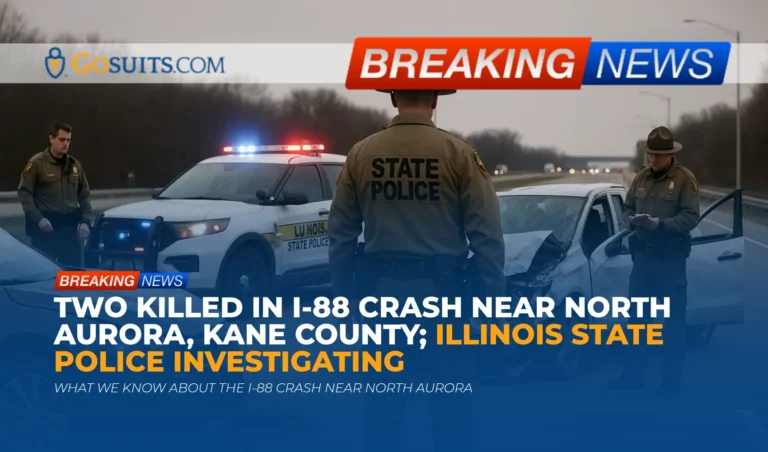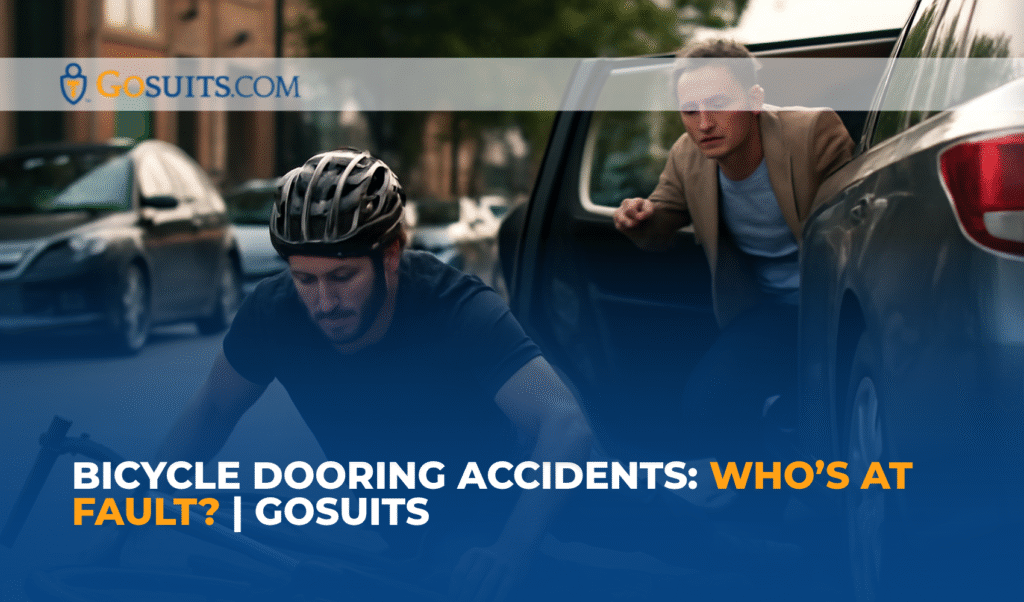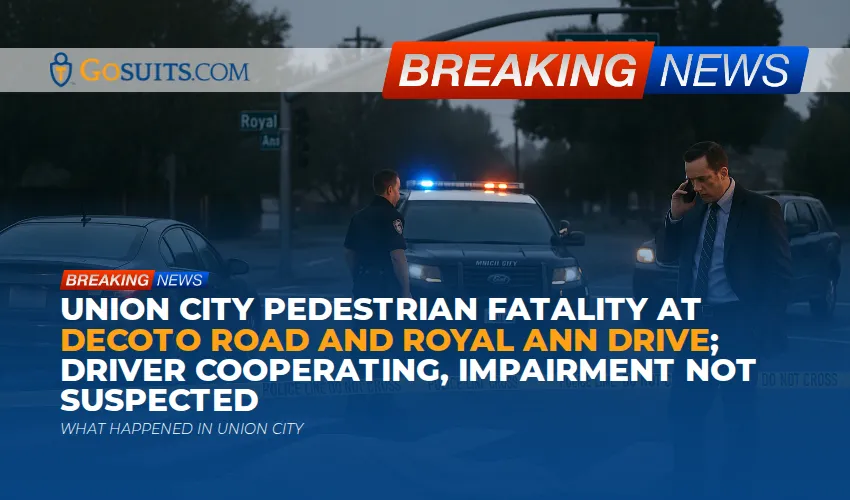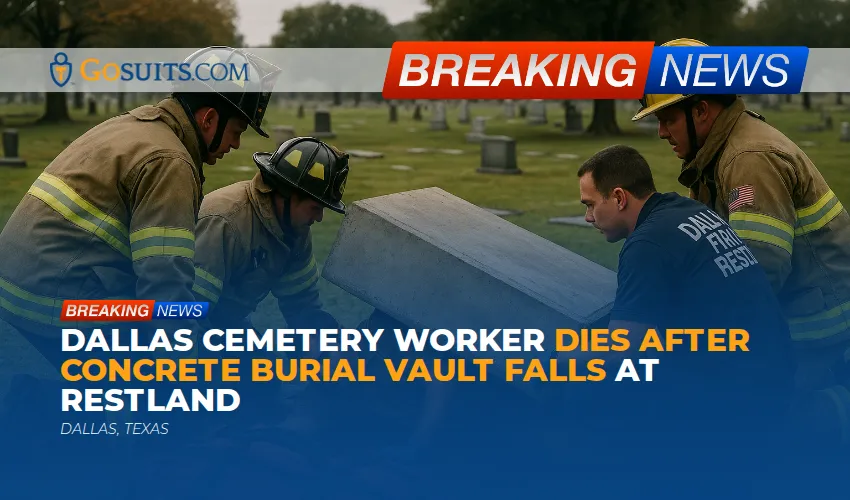- What we know about the I-88 crash near North Aurora
- Timeline and location details
- How fatal crash investigations typically proceed in Illinois
- Key public records families may seek and where to request them
- Potential civil liability considerations in two-vehicle highway collisions
- Insurance issues after a fatal Illinois crash
- Preserving evidence and why timing matters
- Supportive resources and agencies for Kane County families
- Data and safety context: Illinois and national trends
- Practical steps others have taken after similar tragedies
- Commentary from Gosuits North Aurora, Illinois Personal Injury Attorney
- Why timely action matters now
What we know about the I-88 crash near North Aurora
According to information shared by Illinois State Police, two people were killed in a two-vehicle crash on the westbound lanes of Interstate 88 near Mitchell Road in Kane County on Saturday night. Troopers responded at approximately 8:10 p.m. Two lanes were closed for investigation and reopened at about 1:19 a.m. Sunday. As of the reporting, the crash remained under investigation and no additional details were released publicly.
At this stage, critical facts such as contributing factors, vehicle directions of travel, driver conditions, or potential roadway issues have not been provided by authorities. When an investigation is active, agencies typically release updates only after essential evidence is documented and next of kin have been notified.
Timeline and location details
The collision occurred on I-88, commonly known as the Reagan Memorial Tollway, in the westbound lanes near Mitchell Road. This stretch is close to North Aurora in Kane County. Illinois State Police patrol the state’s tollways through District 15, which oversees crash response and investigation on toll facilities statewide. For context on tollway patrol jurisdiction, see Illinois State Police District 15 information here: https://isp.illinois.gov/Patrol/District15.
Key timing noted by authorities:
- Approximate response time: 8:10 p.m. Saturday
- Lane closures: Two westbound lanes closed during investigation
- Reopening time: Around 1:19 a.m. Sunday
Crash investigations on high-speed corridors like I-88 often require extended closures for documentation, measurement, and scene safety. The duration noted here is consistent with a serious or fatal collision where reconstruction steps are needed.
How fatal crash investigations typically proceed in Illinois
After a fatal highway collision, Illinois State Police generally secure the scene, ensure medical response, and preserve evidence. Investigators document roadway conditions, vehicle positions, skid marks, and physical damage. They may collect data from event data recorders (EDRs) when available, and may request recordings from traffic or tollway cameras if relevant.
When a death occurs, the county coroner assumes responsibility for determining cause and manner of death through examination and, where appropriate, autopsy and toxicology. In Kane County, the coroner’s office will coordinate with law enforcement and notify families. Autopsy and toxicology results can take several weeks, depending on lab turnaround.
Because the crash is still under investigation, the public information available is limited. It is normal for agencies to withhold specific findings until the scene analysis, witness interviews, and any relevant testing are complete.
Key public records families may seek and where to request them
Families affected by a fatal crash often need official documents for insurance, probate, and to understand what happened. In Illinois, several records may be available from government agencies. Processing times and eligibility rules apply, and sensitive information may be redacted.
1) Illinois State Police traffic crash report
The primary crash report is prepared by the responding agency. On the tollways, that is typically Illinois State Police District 15. Crash reports can be requested through the Illinois State Police crash reports portal. See: https://isp.illinois.gov/CrashReports.
What to expect:
- Availability: Reports are generally released after review; complex investigations may delay release.
- Contents: Parties and vehicles involved, preliminary diagrams, citations if any, and officer narrative. Some details can be withheld while the investigation is active.
2) Coroner records (Kane County)
The Kane County Coroner’s Office maintains records related to the decedent’s examination, including autopsy and toxicology when performed. For general information and contact, see Kane County’s official site: https://www.kanecountyil.gov and navigate to the Coroner’s Office.
What to expect:
- Autopsy report: Often available to next of kin; timelines vary due to lab processing.
- Toxicology: Results typically take several weeks.
- Cause and manner of death: Issued by the coroner; may be updated if new information arises.
3) Death certificate (State of Illinois)
Certified death certificates are issued through the Illinois Department of Public Health (IDPH) Vital Records or the local county clerk. IDPH guidance on obtaining death records is here: https://dph.illinois.gov/topics-services/birth-death-other-records.
What to expect:
- Eligibility: Typically immediate family or legal representatives.
- Processing: Timeframes vary; rush options may be limited.
- Use: Required for insurance claims, estate steps, and certain benefits.
4) FOIA requests for supplemental records
Some materials such as 911 call audio, dash or body camera video (if used), or additional reports may be requested under the Illinois Freedom of Information Act. Guidance on FOIA in Illinois is available from the Attorney General: https://www.illinoisattorneygeneral.gov/foia.
Note that certain records may be exempt or delayed if release could interfere with an ongoing investigation or if privacy protections apply.
Potential civil liability considerations in two-vehicle highway collisions
While the specific causes of this I-88 crash have not been released, families commonly ask what kinds of factors can create civil liability in serious highway collisions. Illinois civil law focuses on whether a party failed to use reasonable care and whether that failure caused harm. Below are general considerations that often arise in two-vehicle crashes.
Negligence on high-speed corridors
- Speed and following distance: Excessive speed or unsafe following distance can reduce reaction time and increase crash severity.
- Lane changes and merging: Unsafe lane changes, failure to signal, or not yielding when merging can create conflicts at highway speeds.
- Distraction: Device use or other distractions can contribute to missed cues and delayed braking.
- Impairment and fatigue: Alcohol, drugs, and fatigue impair judgment and reaction time.
Evidence to evaluate these issues can include EDR data, video, scene measurements, and witness testimony.
Wrongful death and survival claims in Illinois
When a death is caused by the wrongful act or negligence of another, a civil action may be brought under the Illinois Wrongful Death Act. The action is brought by the personal representative of the decedent for the benefit of the surviving spouse and next of kin. See the Illinois statute: 740 ILCS 180/ Wrongful Death Act. Illinois law also recognizes “survival” claims for the decedent’s injuries and losses before passing, which are maintained by the estate’s representative under the Probate Act. See, generally, Illinois statutes regarding survival actions within the Probate Act (e.g., 755 ILCS 5).
Time limits apply. Many wrongful death and survival claims in Illinois are subject to a two-year limitations period, but shorter deadlines can apply in certain situations. Claims against local public entities are subject to specific limitations and notice rules under the Local Governmental and Governmental Employees Tort Immunity Act. See: 745 ILCS 10/ Tort Immunity Act.

Potential roadway or public entity issues
In some collisions, questions arise about roadway maintenance, signage, or lighting. Claims involving the State of Illinois are typically handled through the Illinois Court of Claims process, which has its own procedures and deadlines. See: Illinois Court of Claims. These matters are highly fact-specific, and governmental immunities can limit or bar claims depending on the circumstances.
Insurance issues after a fatal Illinois crash
Insurance questions surface quickly after a serious collision. Illinois requires liability insurance for vehicles operated on public roadways. For general information on Illinois insurance requirements, see the Secretary of State’s site: https://www.ilsos.gov/departments/vehicles/insurance.html.
Liability insurance and policy limits
- At-fault driver coverage: If another driver is found at fault, their liability policy is the primary source of compensation up to policy limits.
- Underinsured motorist (UIM): When liability limits are insufficient, UIM on the decedent’s or household policies may help.
- Uninsured motorist (UM): If the at-fault vehicle is uninsured, UM may apply.
Communicating with insurers
Insurance adjusters often reach out quickly, sometimes requesting recorded statements or authorizations. People should be careful: statements given early can be used to minimize or dispute claims later. Before making any recorded statement, signing broad medical authorizations, or accepting an early settlement offer, it is prudent to speak with a qualified attorney for a free consultation to understand rights and potential coverage. What someone says to an insurer can be used against them later.
Multiple policies and coordination
Highway crashes may involve multiple policies: the at-fault driver’s liability, UM/UIM coverage, rental or umbrella policies, and policies associated with employers if a driver was on the job. Coordinating these coverages requires careful review of policy language, exclusions, and priority of coverage rules.
Preserving evidence and why timing matters
Key evidence can be lost quickly after a highway crash. Preserving it can clarify what happened and who bears responsibility.
- Vehicle preservation: Post-crash storage and inspection can allow retrieval of EDR data, photos of crush damage, and analysis of restraint systems.
- Scene documentation: Prompt photos or measurements by investigators capture skid marks, debris fields, yaw marks, and gouges that fade with time and traffic.
- Video sources: Traffic cameras, dashcams, business cameras near interchanges, or tollway systems may hold short-retention footage.
- Witness identification: Independent witnesses can be difficult to locate later; names and contact details help preserve their accounts.
- Spoliation letters: Written preservation requests to involved parties or custodians of evidence can reduce the risk of routine deletion.
Because retention windows for digital evidence can be short, acting promptly to identify and preserve potential sources is important.
Supportive resources and agencies for Kane County families
In the wake of a highway tragedy, several public agencies and offices may assist with information or records.
- Illinois State Police (Crash Reports): Official crash reports and some supplemental materials are requested through ISP’s portal: https://isp.illinois.gov/CrashReports.
- Illinois State Police District 15 (Tollways): Patrol and investigation on I-88 and other tollways: https://isp.illinois.gov/Patrol/District15.
- Kane County Coroner’s Office: Information on autopsy and reports; see the county site and navigate to the Coroner: https://www.kanecountyil.gov.
- Illinois Department of Public Health (Vital Records): Death certificates and information: https://dph.illinois.gov/topics-services/birth-death-other-records.
- Freedom of Information Act guidance: Illinois Attorney General FOIA resources: https://www.illinoisattorneygeneral.gov/foia.
Data and safety context: Illinois and national trends
Understanding broader traffic safety patterns can provide context for a single tragic event. Illinois traffic safety data is compiled by the Illinois Department of Transportation (IDOT), which publishes annual crash facts and county-level statistics. See IDOT’s Illinois Roadway Crash Data resources: https://idot.illinois.gov/transportation-system/safety/roadway/Illinois-Roadway-Crash-Data. Illinois has recorded more than 1,000 roadway fatalities in several recent years, reflecting national trends of elevated severe crashes on high-speed corridors.
Nationally, according to the National Highway Traffic Safety Administration (NHTSA), there were 42,939 traffic fatalities in 2021. Speeding-related deaths accounted for a substantial share of fatalities, and alcohol-impaired driving remained a persistent factor. See NHTSA’s Traffic Safety Facts summaries: https://www.nhtsa.gov. While national figures cannot explain a specific crash, they underscore how speed, impairment, distraction, and seat belt use significantly affect outcomes.
For families seeking to understand risk factors and prevention, NHTSA’s resources on occupant protection, impaired driving, and speeding provide accessible, research-based guidance.
Practical steps others have taken after similar tragedies
After a fatal highway collision, logistics and decisions can feel overwhelming. The following steps reflect the kinds of actions many families undertake over time. Each situation is unique; consider the order and timing that fits the circumstances.
- Identify the investigating agency and report number: Confirm with Illinois State Police the district and report identifier. This helps when requesting records later.
- Request certified death certificates: Obtain copies through IDPH or the county clerk to manage insurance claims and estate matters.
- Coordinate with the coroner: Ask about timelines for autopsy and toxicology, and procedures for receiving reports when available.
- Preserve vehicles and personal effects: Ensure the decedent’s vehicle and belongings are preserved, not disposed of, until needed inspections occur.
- Document expenses and communications: Keep a simple log of contacts with insurers and agencies, and save receipts for funeral and related costs.
- Collect potential evidence: Secure any dashcam footage, phone photos, or witness contact information that may exist.
- Review insurance policies: Locate auto, umbrella, and household policies to identify UM/UIM coverage and other benefits.
- Be cautious with insurer outreach: Before giving recorded statements or signing releases, consider consulting an attorney for a free consultation to understand rights and strategy. What is said to insurers can be used to dispute claims later.
- Consider probate steps: Appointing a personal representative may be necessary to request certain records and to bring civil claims on behalf of the estate or next of kin.

Commentary from Gosuits North Aurora, Illinois Personal Injury Attorney
Our hearts are with everyone affected by the loss reported on I-88 near North Aurora. The information provided here is for educational purposes and general information, meant to help community members understand how investigations unfold and what records and rights may be involved after a serious crash.
On fast-moving tollway corridors, a two-vehicle collision severe enough to claim lives raises urgent questions about speed, spacing, lane changes, and potential impairment or distraction. It also raises questions about whether all available evidence will be preserved. Thorough investigations take time, and families often have to wait for official reports and coroner findings before they receive clear answers.
In our experience, insurance carriers and corporate stakeholders often move quickly after a fatal crash to shape the narrative and limit exposure. Adjusters may request recorded statements or broad releases early on, before all the facts are documented. These tactics can take advantage of people’s lack of familiarity with complex coverage issues, the interplay of multiple policies, and the value of certain damages under Illinois law. Simple, well-intended answers can later be used to limit or deny claims.
A free consultation with a seasoned attorney can provide clarity about rights, timelines, evidence preservation, and the coordination of insurance benefits, including uninsured or underinsured motorist coverage. Speaking with counsel first can help ensure that communications with insurers are accurate, limited to what is necessary, and timed appropriately so that important evidence is available when needed.
Why timely action matters now
After a major highway crash, important rights and evidence are time-sensitive. Taking measured steps sooner rather than later can improve access to records, reduce the risk of lost evidence, and avoid missteps with insurers. Below is a lens on what action commonly looks like, why timing matters, and the practical benefits of moving forward thoughtfully.
- Confirm the investigation details: Identify the investigating agency (for I-88, typically Illinois State Police District 15) and obtain the incident number. Benefit: Enables efficient records requests and follow-up without delays.
- Request vital records early: Begin the process for certified death certificates through IDPH and inquire with the coroner about report timelines. Benefit: Supports insurance, employment benefits, and estate needs that may be time-sensitive.
- Secure and preserve the vehicle: Ensure any involved vehicle is not destroyed or released for salvage. Benefit: Preserves EDR data and physical evidence that can be crucial to understanding causation.
- Identify potential video sources quickly: Camera systems often overwrite footage within days. Benefit: Early preservation efforts increase the chance of capturing useful video and corroborating evidence.
- Organize insurance information: Gather policies and declarations pages from auto, umbrella, and household coverage. Benefit: Clarifies potential UM/UIM benefits and helps prioritize communications.
- Consult an attorney before insurer statements: Seek a free consultation to understand what to say, what documents to sign, and when to engage with adjusters. Benefit: Avoids avoidable statements or authorizations that could narrow or undermine civil claims later.
- Calendar key deadlines: Note general statutes for wrongful death and survival claims, and recognize shorter windows may apply to public entities. Benefit: Preserves access to the civil justice process by avoiding missed deadlines.
Acting deliberately and with awareness helps protect the integrity of the investigation and the ability to pursue appropriate civil remedies under Illinois law.
Key legal and public information sources
These government resources can help with records and understanding the legal landscape in Illinois:
- Illinois State Police Crash Reports
- Illinois State Police District 15 (Tollways)
- Kane County government site (Coroner information)
- Illinois Department of Public Health Vital Records
- Illinois Attorney General FOIA guidance
- Illinois Wrongful Death Act (740 ILCS 180)
- Tort Immunity Act (745 ILCS 10)
- Illinois Court of Claims
- Illinois Secretary of State: Vehicle Insurance
- IDOT Illinois Roadway Crash Data
- National Highway Traffic Safety Administration






